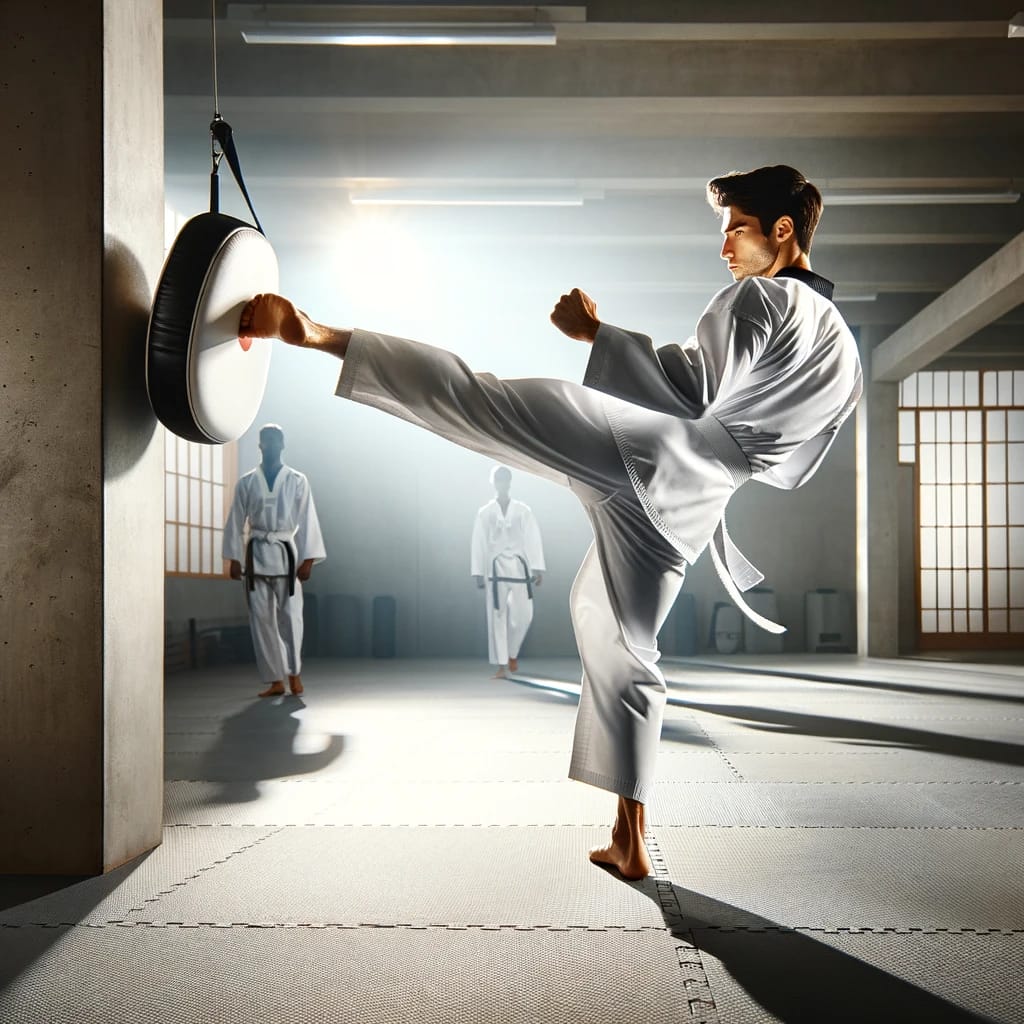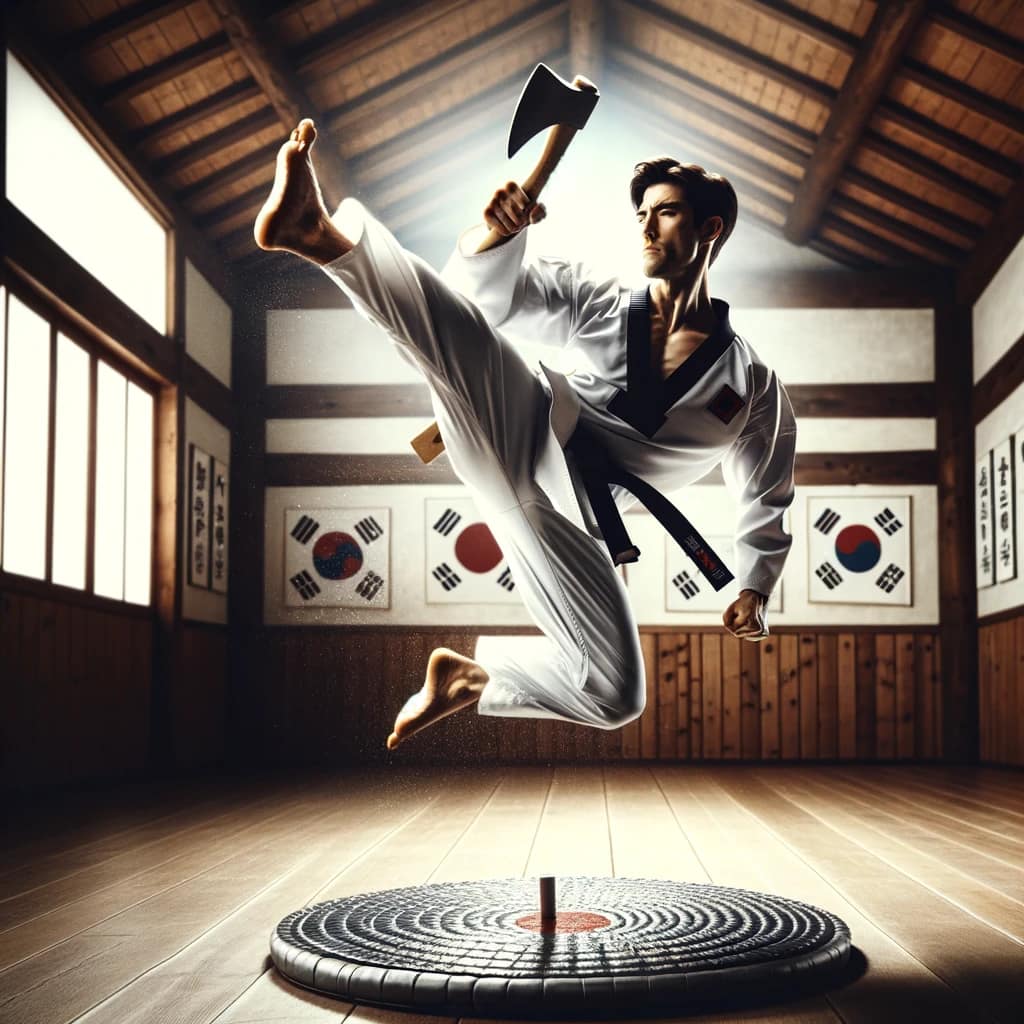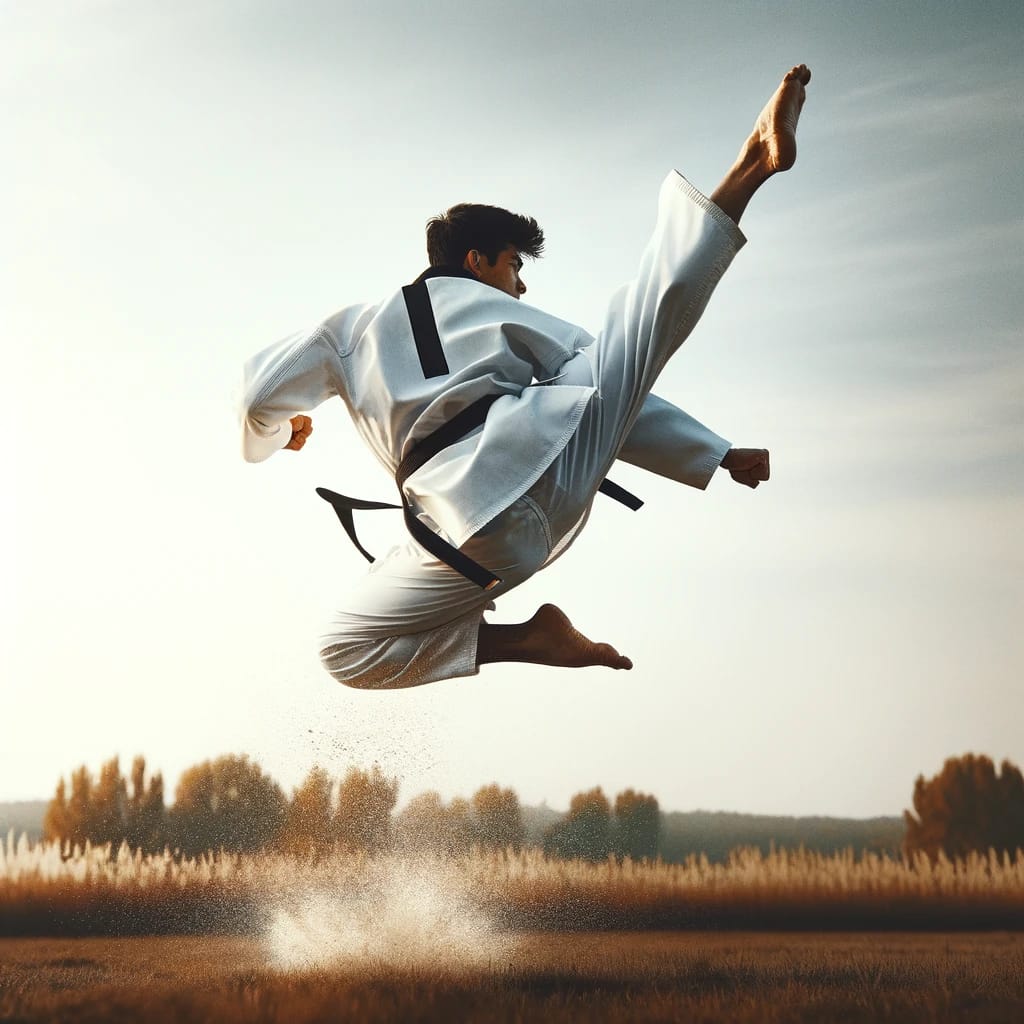10 Taekwondo Kicks That Will Make You Unstoppable!
Table of Contents
Welcome to the exciting world of Taekwondo, where agility, speed, and precision meet to create a dynamic martial art loved by millions around the globe. Whether you’re a beginner eager to learn the basics or a seasoned practitioner aiming to refine your skills, mastering the art of kicking is crucial in Taekwondo. Today, I’m thrilled to share with you the top 10 Taekwondo kicks that, once mastered, will truly make you unstoppable!
The Foundation of Taekwondo Kicks
Before we dive into the kicks, let’s set the groundwork. Taekwondo is known for its emphasis on high flying kicks and rapid footwork. Each kick serves a purpose, whether it’s to strike an opponent, defend against an attack, or demonstrate technical prowess in patterns (poomsae) and sparring (kyorugi).
Why Kicks Matter
In my early days of training, I quickly learned that Taekwondo isn’t just about throwing your leg in the air; it’s about balance, technique, and the ability to anticipate your opponent’s next move. Kicks are the soul of Taekwondo, and mastering them can elevate your practice from good to great.
Top 10 Must-Learn Taekwondo Kicks
1. Front Kick (Ap Chagi)
The front kick is your bread and butter. It’s one of the first kicks you’ll learn, emphasizing straight-line attacks to the opponent’s body or face. Perfecting the front kick taught me the importance of accuracy and power, fundamentals that apply to every aspect of Taekwondo.

The Front Kick, or Ap Chagi, is foundational in Taekwondo, serving as a cornerstone for both beginners and advanced practitioners alike. This kick is about striking and balance, posture, and the ability to control one’s body. It’s a versatile technique that can be used defensively to keep an opponent at bay or offensively to score points in sparring and competitions.
Technique and Application
Executing a powerful Front Kick involves a few critical steps:
- Starting Position: Begin in a balanced stance, with your knees slightly bent and your weight evenly distributed on both feet.
- Chambering: Lift your knee towards your chest, which is the chamber position for the kick. The higher you can chamber your knee, the more control and power you will have.
- Extension: Rapidly extend your leg, driving your foot (usually the ball of the foot) towards the target. Your body should lean slightly back to counterbalance the kick.
- Rechamber and Return: After striking, rechamber your leg by pulling the knee back towards your chest before placing your foot back down. This action prepares you for the next move and helps maintain balance.
Training and Drills
Practising the Front Kick requires focus on both technique and power. Training often starts with slow, controlled movements focusing on form and gradually increases speed and power as proficiency improves. Kick pads, heavy bags, and even shadow kicking in front of a mirror are excellent ways to refine your technique.
Strategic Use in Sparring
In sparring, the Front Kick can serve multiple purposes. It can be a quick, straight-line attack to catch an opponent off-guard or used defensively to create distance between you and your opponent. Its versatility lies in its simplicity and effectiveness, making it a reliable technique in any Taekwondo practitioner’s arsenal.
Common Mistakes to Avoid
- Overextending: Kicking beyond your balance can lead to falling forward, leaving you vulnerable to counter-attacks.
- Telegraphing: Moving your shoulders or arms excessively before kicking can signal your intentions to your opponent.
- Poor Chambering: Failing to chamber the knee properly can reduce the kick’s power and effectiveness.
Resource for Further Learning
For those looking to delve deeper into the art of the Front Kick and other Taekwondo techniques, “Taekwondo: The State of the Art” by Master Sung Chul Whang and Dr Jun Chul Whang provides comprehensive insights into Taekwondo’s philosophy, techniques, and applications. This book is an excellent resource for practitioners of all levels seeking to enhance their understanding and mastery of Taekwondo.
In conclusion, the Front Kick is much more than a basic technique; it embodies the principles of Taekwondo—balance, control, and power. Mastery of the Front Kick paves the way for learning more complex techniques, making it an essential part of any practitioner’s training regimen.
2. Roundhouse Kick (Dollyo Chagi)
This kick is all about flexibility and speed. It’s a versatile move that can target various levels—low, medium, or high—making it a staple in competitions. I remember spending hours perfecting my roundhouse kick, aiming to hit the target with the top of my foot for maximum impact.

The Roundhouse Kick (Dollyo Chagi) is a fundamental yet dynamic technique in Taekwondo, epitomizing the martial arts’s emphasis on speed, agility, and precision. This kick is not only about striking with force but also about the elegance of movement, requiring the practitioner to balance power with flexibility. The beauty of the roundhouse kick lies in its adaptability; it can be executed at various heights and speeds, making it unpredictable and a critical tool in both sparring and forms.
Technique and Application
Executing a successful roundhouse kick involves a swift rotation of the body and hips, combined with a snapping motion of the leg. This kick targets the opponent’s side, often aiming for the head, ribs, or thighs. The key to maximizing its impact lies in the speed of the leg’s extension and the precise moment of contact with the target—ideally with the instep or the ball of the foot for penetrating power.
Training and Improvement
Improving your roundhouse kick requires consistent practice, focusing on flexibility, balance, and strength. Stretching exercises, particularly those that enhance hip flexibility and leg strength, are crucial. Practitioners often use target pads or heavy bags to refine their aim and power, gradually increasing the speed and force of their kicks. Drills that involve changing kick heights and speeds can also enhance muscle memory and control, making the roundhouse kick both a versatile and formidable technique in a Taekwondo practitioner’s arsenal.
Strategic Use in Sparring
In sparring, the roundhouse kick is a versatile weapon. Its ability to be delivered at different heights allows practitioners to keep their opponents guessing, making it an effective feint or setup for combinations. The kick’s speed makes it difficult to block or counter, especially when executed as a follow-up to other techniques. Mastery of the roundhouse kick can often be a deciding factor in competitive Taekwondo, where speed, precision, and strategy converge.
Conclusion
The roundhouse kick is a testament to the elegance and effectiveness of Taekwondo. It symbolizes the martial arts philosophy of harmonizing strength with grace, embodying the physical and mental discipline required to achieve mastery. Whether you’re a beginner or an experienced martial artist, dedicating time to perfect this kick can elevate your practice and bring you closer to the essence of Taekwondo.
Resources
For those looking to deepen their understanding and improve their roundhouse kick technique, resources such as the “Taekwondo Training Manual” or the online course “Mastering Taekwondo: Kicks” can be invaluable. These resources offer detailed instructions, drills, and insights from seasoned Taekwondo masters, providing practitioners with the tools to refine their skills and achieve their martial arts goals.
3. Side Kick (Yop Chagi)
The side kick is a powerful demonstration of strength, delivering a forceful blow with the side or heel of your foot. It’s excellent for defense and counterattacks. I’ve used the side kick in sparring to maintain distance from my opponents, proving its effectiveness time and again.

The sidekick (Yop Chagi) is not just a technique; it’s a statement of power, precision, and control in the world of Taekwondo. This kick is a fundamental move that every practitioner learns early on, yet it takes a lifetime to master. The effectiveness of the sidekick lies in its versatility. It can be used for defence, to keep an aggressive opponent at bay, or as a potent offensive move to penetrate an opponent’s guard.
The Mechanics of the Side Kick
The sidekick begins with a turning of the body sideways towards the target, lifting the knee of the kicking leg across the body. Then, with a powerful extension of the leg, the practitioner strikes with the side or heel of the foot. Proper alignment of the hips and shoulders is crucial to deliver maximum force. The retraction of the kicking leg is just as important as the extension, ensuring the practitioner remains balanced and ready for the next move.
Training the sidekick
Training for a powerful sidekick involves a combination of flexibility, strength, and technique drills. Flexibility exercises such as leg stretches are essential for achieving the high and precise kicks Taekwondo is known for. Strength training, particularly for the legs, hips, and core, enhances the kick’s power. Lastly, technique drills, often done with a heavy bag or target pads, help refine accuracy and control.
Application in Sparring and Self-Defense
In sparring, the sidekick serves multiple purposes. It can create distance between you and your opponent, interrupt their advances, or score points with its precision and power. Its utility in self-defence cannot be overstated. A well-executed sidekick aimed at an attacker’s knee or midsection can neutralize a threat effectively, showcasing its practicality beyond the dojang.
Resources for Mastering the Side Kick
- Taekwondo Training Manuals: Books like “Complete Taekwondo Poomsae” by Kyu Hyung Lee and Sang H. Kim provide detailed instructions on forms that include the sidekick, offering insights into its application in various scenarios.
- Online Courses and Tutorials: Platforms like YouTube have countless tutorials from seasoned Taekwondo masters. Channels like TaekwonWoo or Kwonkicker offer in-depth breakdowns of the sidekick, including slow-motion videos that detail every phase of the kick.
- Taekwondo Schools and Clubs: Nothing beats learning under the guidance of an experienced instructor. Many Taekwondo schools and clubs offer personalized coaching to help refine your sidekick, along with sparring sessions to practice its application in real-time scenarios.
The sidekick is more than just a move in your Taekwondo arsenal; it’s a tool that shapes the way you move, think, and react. Its power lies not only in the physical force it delivers but also in the discipline, precision, and patience required to execute it flawlessly. Whether you’re training for competition, self-defence, or personal growth, the sidekick remains a foundational pillar of your Taekwondo journey.
4. Back Kick (Dwit Chagi)
Stealthy and surprising, the back kick is delivered by looking over your shoulder and striking backward. It’s fantastic for catching an opponent off guard. One of my most memorable sparring matches was won with a well-timed back kick that my opponent never saw coming.

The back kick, or Dwit Chagi, holds a special place in the arsenal of Taekwondo techniques for its effectiveness in both defence and counter-attack scenarios. This kick is not only about power but also about the element of surprise, making it a formidable move in the hands of a skilled practitioner.
Technique and Application
To execute a backkick properly, a practitioner must first turn their back to the target, looking over their shoulder to aim. The kick is then delivered by thrusting the heel backwards into the target, using the body’s rotation to generate power. This technique requires a good sense of balance, coordination, and spatial awareness, as the practitioner must accurately judge the distance and timing without directly facing the opponent.
Strategic Use in Sparring
In sparring, the backkick can be a game-changer. Its power and speed make it difficult to block or evade when executed correctly. The key is in the setup; a well-practised practitioner will often use footwork or feints to create the right moment for this kick, making it unexpected and highly effective. My memorable match-winning moment came from such a setup, where the backkick was unleashed at an angle my opponent didn’t anticipate, leading to a decisive point.
Training and Drills
Training for the backkick involves several key components. Practitioners should focus on drills that enhance their ability to quickly turn and spot their target, ensuring accuracy and power in the kick. Strength and conditioning exercises that build the leg muscles, particularly the hamstrings and glutes, are also beneficial. Plyometric exercises can improve explosive power, essential for delivering a forceful backkick.
Resources for Mastery
To master the backkick, consider the following resources:
Instructional Videos: Many Taekwondo masters and instructors share their knowledge through online platforms. Videos can provide step-by-step guidance on the mechanics of the backkick, demonstrating proper form and technique.
Taekwondo Dojangs: Joining a dojang (Taekwondo school) offers the benefit of personalized instruction. Experienced instructors can provide real-time feedback, helping you refine your backkick and integrate it effectively into your sparring strategy.
Books and Manuals: Several comprehensive guides on Taekwondo cover the backkick in detail. These resources often include diagrams, photos, and expert tips to help practitioners understand the nuances of the kick.
Seminars and Workshops: Participating in Taekwondo seminars or workshops can be an excellent way to learn from high-level athletes and coaches. These events sometimes focus on specific techniques, including the backkick, and offer a deeper dive into strategy and application.
In conclusion, the backkick is a powerful and strategic technique that, when mastered, can significantly enhance a practitioner’s competitiveness in sparring. Through dedicated practice, study, and guidance from experienced instructors, anyone can develop the precision and power needed to execute this kick effectively. Remember, the success of the backkick lies not only in physical preparation but also in the element of surprise and the ability to read your opponent.
5. Hook Kick (Huryeo Chagi)
The hook kick swings around to strike the opponent with the heel. It requires a blend of balance and control that I found challenging but rewarding to master. When executed correctly, it’s a beautiful and devastating move.

The Hook Kick, or Huryeo Chagi in Taekwondo, is a sophisticated technique that embodies the martial arts’s blend of beauty and lethality. This kick involves swinging your leg in a hooking motion to strike the target, usually the head or the body, with your heel. Mastery of the Hook Kick demands not only physical prowess but also a deep understanding of timing and distance.
The Mechanics of the Hook Kick
To execute a Hook Kick effectively, you start by raising your knee in the direction of the target, similar to the initial motion of a side kick. However, instead of pushing forward, you extend your leg out and then snap it back in a hooking motion towards the target. The power comes from the speed of the hooking action and the precision of the heel strike.
Training Tips
- Flexibility and Strength Training: Flexibility in the hamstrings and strength in the core and leg muscles are crucial. Incorporate stretching routines and strength training exercises that target these areas.
- Balance Exercises: Balance is key to maintaining control during the kick. Practice standing on one leg and performing slow, controlled hook kicks to improve your balance and technique.
- Drills and Paddle Work: Work with a partner and practice your Hook Kick on kicking paddles or targets. This will help you understand the range and improve accuracy.
- Shadow Sparring: Practicing your Hook Kick in shadow sparring allows you to work on your footwork and the incorporation of the kick into your sparring strategy.
Applications in Sparring
In sparring, the Hook Kick can be used both offensively and defensively. Offensively, it can surprise an opponent by coming around their guard. Defensively, it can be used to create distance or counter an attack. The key to successfully using the Hook Kick in sparring lies in your ability to disguise it within combinations or use it when your opponent least expects it.
Challenges and Rewards
Mastering the Hook Kick was a journey that tested my patience and dedication. The initial challenge was the flexibility required to execute the kick effectively. However, with consistent practice and focusing on flexibility, the kick became not just a technique in my arsenal but a favourite move to surprise opponents.
Resources
For those looking to master the Hook Kick or incorporate it into their Taekwondo practice, consider the following resources:
- Online Tutorials: Many Taekwondo masters share their expertise through online platforms. YouTube channels like TaekwonWoo or Kwonkicker offer detailed breakdowns of the Hook Kick and drills for practice.
- Taekwondo Training Apps: Apps like “Taekwondo Training” provide step-by-step instructions and training routines for various Taekwondo techniques, including the Hook Kick.
- Books on Taekwondo Techniques: Books such as “Complete Taekwondo Poomsae” by Kyu Hyung Lee and Sang H. Kim offer insights into the traditional forms and techniques, providing a deeper understanding of martial arts.
- Local Dojangs: Joining a local Taekwondo dojang or club provides the opportunity to learn and practice under the guidance of experienced instructors.
- Seminars and Workshops: Keep an eye out for Taekwondo seminars and workshops in your area. These events often feature high-ranking Taekwondo masters who can offer personalized feedback and advanced techniques.
Embracing the Hook Kick is embracing a part of Taekwondo that is as much about grace as it is about power. It’s a testament to the martial arts’s depth and the endless journey of learning and improvement.
6. Axe Kick (Naeryeo Chagi)
Descending from above, the axe kick can break through an opponent’s guard with sheer power. I’ve always admired the axe kick for its straightforwardness and the element of surprise it brings, especially when aimed at the collarbone or head.

The axe kick, or Naeryeo Chagi in Taekwondo, stands out as a particularly potent technique capable of overpowering an opponent with its unique downward force. This kick begins with the practitioner lifting their leg as high as possible, then forcefully bringing the heel down towards the target. The power generated from the height and gravity adds to its effectiveness, making it a formidable move against opponents, whether in sparring, competition, or self-defence scenarios.
Key Aspects of the Axe Kick:
- Technique Precision: Mastery of the axe kick requires precise technique, starting with a proper stance to ensure balance and power. The leg must be lifted straight up, with the heel leading the downward motion to strike the target.
- Flexibility: High flexibility is essential to execute the kick effectively, allowing the practitioner to reach significant heights with their leg before driving it down.
- Speed and Timing: The effectiveness of an axe kick also relies on the speed of execution and timing. A swift, unexpected axe kick can be difficult for opponents to block or evade.
- Target Areas: While the axe kick can be aimed at various body parts, targeting the collarbone, shoulder, or head in taller opponents, or even the spine, can be particularly devastating. However, in practice and sparring, safety and control are paramount to prevent injury.
Training Tips:
- Stretch Regularly: Enhance your flexibility through consistent stretching, focusing on the hamstrings, hips, and lower back to improve the height and speed of your axe kick.
- Strength Training: Strengthen the muscles used in the axe kick, particularly the core, legs, and lower back, to increase the power behind your kick.
- Practice with Pads: Work with a partner or trainer using pads to practice the motion and impact of your axe kick, helping to refine your accuracy and power.
- Shadow Training: Practice the axe kick in front of a mirror or during shadow boxing sessions to improve your form and technique without the need for equipment.
Resources:
For those looking to delve deeper into mastering the axe kick, several resources are available:
- Online Tutorials: YouTube and martial arts websites often feature tutorials from experienced practitioners who can provide step-by-step guidance.
- Taekwondo Schools: Many dojangs offer classes focused on technique improvement, where you can receive personalized feedback on your axe kick.
- Books and Manuals: Several Taekwondo books detail the mechanics and applications of the axe kick, offering drills and tips for practitioners of all levels.
The axe kick is not just a testament to the physical capabilities of Taekwondo practitioners but also a reflection of the strategic depth within the martial art. By incorporating this kick into your repertoire, you not only expand your attacking options but also cultivate a sense of timing, precision, and power that can enhance all aspects of your Taekwondo practice.
7. Crescent Kick (Bandal Chagi)
There are two variations: the inward and the outward crescent kick. Both are essential for developing flexibility and can be used to deflect incoming attacks. Practicing crescent kicks has dramatically improved my ability to switch directions swiftly.

The Crescent Kick, or Bandal Chagi, is a fundamental yet visually impressive technique in Taekwondo that showcases a practitioner’s flexibility and control. It involves a circular motion of the leg, which can be executed inwards (An Bandal Chagi) or outwards (Bakat Bandal Chagi), making it a versatile move in both forms and sparring. The inward crescent kick starts from the outside, moving towards the inside, while the outward crescent moves in the opposite direction. Both variations serve distinct purposes and can be adapted to different combat scenarios.
Inward Crescent Kick (An Bandal Chagi)
This kick is particularly effective for deflecting or clearing an opponent’s guard, creating an opening for further attacks. The inward motion can also be deceptive, as it starts in a direction that seems non-threatening before swiftly changing course towards the target. It’s an excellent technique for developing hip flexibility and control, as the motion requires a significant range of motion.
Outward Crescent Kick (Bakat Bandal Chagi)
The outward crescent kick is often used for striking the side of an opponent’s head or body. It can also be a powerful tool for blocking or redirecting an incoming kick. The outward motion requires a practitioner to have good balance and coordination, as it involves a wide, sweeping movement.
Training Tips
- Start Slow: Begin by practising the motion of the crescent kick slowly to understand the path your foot should take. This will help improve your muscle memory for the kick.
- Use Targets: Practice with targets at different heights to improve your accuracy and control. This can also help you adjust the trajectory of your kick based on the intended target.
- Work on Flexibility: Flexibility is key to performing an effective crescent kick. Incorporate dynamic stretching into your warm-up routine to improve your range of motion.
- Balance Exercises: Since the crescent kick involves a wide range of motion, balance exercises can help you maintain stability during the kick. Practices like yoga or Pilates can be beneficial.
Applications in Taekwondo
The crescent kick is not only a technique for striking but also a way to improve overall body mechanics, including balance, coordination, and flexibility. It’s often used in patterns (poomsae) and sparring to demonstrate technical prowess and strategic manoeuvring.
Resources
For those looking to master the crescent kick, consider the following resources:
- Online Tutorials: Platforms like YouTube offer detailed tutorials from seasoned Taekwondo practitioners that break down the steps for each variation of the crescent kick.
- Taekwondo Schools: Many dojangs (Taekwondo schools) focus on the technical aspects of kicks, offering personalized feedback that can accelerate your learning.
- Books and Guides: There are numerous Taekwondo manuals and guides that include step-by-step instructions and photographs for the crescent kick and other techniques.
Practising the crescent kick has been a transformative experience for me, significantly enhancing my agility and ability to execute complex combinations. Whether you’re a beginner or a seasoned practitioner, dedicating time to perfect this kick can open up new dimensions in your Taekwondo journey.
8. Tornado Kick (Dwi Huryeo Chagi)
This kick is as cool as it sounds. It combines turning, jumping, and kicking in a single, fluid motion. Landing a tornado kick during a demonstration made me feel like a real-life action hero. It’s a crowd-pleaser and a testament to the practitioner’s skill and agility.

The Tornado Kick, or Dwi Huryeo Chagi in Taekwondo, is not just a testament to a practitioner’s physical prowess but also a reflection of their dedication and mastery of the art. This kick involves a complex blend of techniques that include turning, jumping, and kicking—all executed in a seamless, fluid motion that resembles the powerful force of a tornado. It’s a kick that demands precision, balance, and timing, making it one of the most challenging yet rewarding techniques to learn and master in Taekwondo.
Why the Tornado Kick Stands Out
The tornado kick stands out for its spectacular visual appeal and the high level of skill it requires. When performed correctly, the practitioner leaps into the air, spins, and delivers a powerful kick, all in one continuous motion. This not only demonstrates the athlete’s agility and strength but also their ability to control their body with exceptional precision.
The Technique Behind the Kick
The key to a successful tornado kick lies in the preparatory steps leading up to the kick itself. It starts with a pivot on the lead foot, followed by a knee raise from the back leg to generate the spin. As the body turns, the practitioner jumps off the ground, using the momentum of the spin to lift into the air. The kick is then delivered with the same leg that started the knee raise, striking the target with power and accuracy.
Training for the Tornado Kick
Training for the tornado kick involves several key components:
- Strength and Flexibility Training: Building leg strength and improving overall flexibility are essential for achieving the high jump and full rotation required.
- Balance Exercises: Balance is crucial for executing the spin and landing safely. Practitioners often use balance training exercises to improve their stability.
- Technique Drills: Breaking down the kick into smaller components and practising each part separately can help in mastering the overall motion.
- Sparring Practice: Incorporating the tornado kick into sparring sessions can help practitioners understand its practical application and timing.
Resources for Learning the Tornado Kick
For those interested in learning the tornado kick or enhancing their technique, several resources can be invaluable:
- Online Tutorials: Many experienced Taekwondo instructors offer detailed tutorials on YouTube and martial arts websites that break down the steps of the tornado kick.
- Taekwondo Classes: Joining a Taekwondo class or seminar that focuses on advanced techniques like the tornado kick can provide hands-on instruction and feedback.
- Training Apps: Some martial arts training apps include modules or lessons on specific kicks, including the tornado kick, allowing practitioners to learn at their own pace.
The Tornado Kick in Action
Seeing the tornado kick in action, whether in a demonstration, competition, or film, is always thrilling. It captures the essence of Taekwondo’s dynamic and powerful nature, inspiring both practitioners and spectators alike. For those in the martial arts community, landing a tornado kick is a milestone achievement that symbolizes a high level of skill and dedication to the art.
In summary, the tornado kick is more than just a kick; it’s a blend of art, strength, and discipline. Its mastery is a journey that challenges practitioners to push their limits and achieve new heights in their Taekwondo practice.
9. Jumping Front Kick (Twieo Ap Chagi)
Adding a jump to the front kick elevates its power and reach. It’s a dynamic move that can surprise your opponent and score high in competitions. My first successful jumping front kick in a tournament was a game-changer, showing me the power of combining basic techniques with aerial elements.

The Jumping Front Kick, or Twieo Ap Chagi, is not just a technique; it’s a statement. It demonstrates a practitioner’s agility, strength, and ability to leverage momentum for both offensive and defensive purposes. This kick is a testament to the hours of rigorous training, flexibility exercises, and the mastery of basic front kicks that are prerequisites for executing such an aerial manoeuvre effectively.
The Mechanics of the Jumping Front Kick
Executing a successful jumping front kick involves several key components. Firstly, the practitioner must gain sufficient height during the jump to increase the kick’s impact and reach. This requires strong leg muscles and good timing. Secondly, maintaining balance and control in the air is crucial. The body must be aligned correctly to deliver the kick with precision. Finally, focusing on the target and ensuring that the foot hits accurately is what makes this kick not just a show of skill but a practical attack or counter in sparring and competitions.
Training Tips
- Strength and Conditioning: Focus on exercises that build leg strength, such as squats and lunges, and plyometric exercises to improve explosive power.
- Flexibility: Incorporate stretching routines into your daily practice to increase the range of motion, which is crucial for achieving higher jumps and better kick execution.
- Practice Basic Front Kicks: Mastery of the basic front kick is essential. Ensure your technique is solid on the ground before adding the jump.
- Drills: Start with low-intensity jump kicks, gradually increasing the height and power as your confidence and skill improve. Using a target or heavy bag can help with accuracy and power.
Resources
To further refine your Jumping Front Kick, consider the following resources:
- Online Tutorials: Platforms like YouTube have countless instructional videos from Taekwondo masters worldwide. Look for tutorials that break down the kick step by step.
- Taekwondo Schools: Many dojangs offer specialized classes focusing on advanced techniques, where you can learn and practice the jumping front kick under expert supervision.
- Books and Guides: There are comprehensive Taekwondo manuals authored by renowned masters that include detailed sections on advanced kicking techniques, including the jumping front kick.
Personal Anecdote
My journey with the jumping front kick was transformative. Initially, it was challenging to coordinate the jump with the kick’s execution. However, with persistence and guidance from my instructors, I saw significant improvement. The first time I successfully used it in a tournament, it was not just a point scored; it was a moment of realization about the effectiveness of combining basic skills with advanced techniques. The kick has since become a staple in my repertoire, a tool that I continuously refine.
Conclusion
The Jumping Front Kick is more than just a technique; it’s a symbol of the heights (quite literally) that dedication, training, and the spirit of Taekwondo can achieve. Whether for competition, self-defence, or demonstration, mastering this kick adds a dynamic layer to your martial arts skills that can truly make you unstoppable.
10. Flying Side Kick (Twimyo Yop Chagi)
The flying side kick is the epitome of Taekwondo’s dynamic nature. It involves running, jumping, and then executing a powerful side kick mid-air. It’s a challenging move that requires practice and fearlessness. Achieving it was a milestone in my Taekwondo journey, symbolizing my growth and perseverance.

The flying sidekick, or Twimyo Yop Chagi, stands as one of the most visually impressive and technically challenging techniques in the realm of Taekwondo. This kick not only showcases the practitioner’s physical prowess but also their understanding of timing, distance, and aerial control. It is a testament to one’s dedication to the martial art, embodying the essence of Taekwondo’s dynamic and explosive nature.
Execution and Technique
To perform a flying sidekick, the practitioner begins with a running start to build momentum. This is followed by a leap, during which the body is propelled into the air. At the peak of the jump, the practitioner executes a sidekick, targeting an imaginary or actual target at or above their head height. The non-kicking leg is bent and pulled in to facilitate rotation and height in the jump, while the arms are used to balance and generate additional force. Landing safely requires as much skill and control as the kick itself, making the entire movement a complex combination of agility, strength, and precision.
Training Tips
- Start with Basics: Mastery of the basic sidekick is essential before attempting its flying variant. Focus on developing strength, flexibility, and control.
- Build Lower Body Strength: Exercises like squats, lunges, and plyometrics can enhance the power of your jump and kick.
- Improve Flexibility: Stretch regularly to increase leg flexibility, which is crucial for achieving higher kicks.
- Practice Jumping Techniques: Work on your jumping skills to improve elevation. Activities like skipping rope or box jumps are beneficial.
- Use Training Aids: Practicing with a target or a kicking pad held at varying heights can help gauge accuracy and power. Initially, use a lower height to ensure safety and gradually increase as you become more comfortable.
Safety Considerations
Given its complexity, the flying sidekick poses a risk of injury if performed incorrectly. Practitioners should ensure they are in a suitable physical condition before attempting this kick. Training under the supervision of a qualified Taekwondo instructor is highly recommended. Additionally, practising in a safe environment, preferably with mats or a soft surface, can reduce the risk of injury during falls or missteps.
Resources
For those looking to refine their flying sidekick or learn more about it, several resources can be invaluable:
- Taekwondo Training Manuals: Books and manuals by Taekwondo masters provide insights into the technique and philosophy behind the kick.
- Online Tutorials and Videos: Numerous instructional videos are available online, offering step-by-step guidance from experienced practitioners.
- Taekwondo Workshops and Seminars: Participating in workshops led by Taekwondo experts can offer personalized feedback and advanced training techniques.
Achieving proficiency in the flying sidekick is a significant accomplishment in any Taekwondo practitioner’s journey. It represents not only technical skill but also a deep commitment to the art of Taekwondo. With patience, practice, and perseverance, the flying sidekick can be a thrilling and rewarding aspect of your martial arts practice, symbolizing your growth, strength, and fearlessness.
Final Thoughts
For the rich tapestry of skills and philosophies that Taekwondo encompasses. Each kick, from the fundamental front kick to the complex flying side kick, offers a unique blend of physical challenge and mental discipline. They embody the core principles of Taekwondo: courtesy, integrity, perseverance, self-control, and indomitable spirit. As you progress in your training, these kicks become more than just techniques; they become expressions of your personal growth and commitment to the martial art.
Resources for Further Learning
World Taekwondo (WT) – The official website of the World Taekwondo Federation provides resources on Taekwondo’s history, techniques, and competitions. Visit World Taekwondo for more information.
International Taekwon-Do Federation (ITF) – Explore the ITF’s take on Taekwondo, including detailed explanations of patterns, kicks, and philosophies at the International Taekwon-Do Federation.
Taekwondo Techniques and Training – For a comprehensive guide to Taekwondo techniques, including videos and tutorials on kicks and forms, check out Taekwondo Techniques and Training.
YouTube Channels – Numerous channels dedicated to Taekwondo training offer step-by-step video tutorials on kicks and other techniques. Channels like TaekwonWoo and Kwonkicker provide valuable visual aids to complement your training.
Local Dojangs and Clubs – Joining a local Taekwondo club or dojang is invaluable. Direct mentorship and sparring with peers will accelerate your learning and understanding of these kicks in a practical setting.
Final Thoughts
Mastering these 10 kicks will not only make you a formidable practitioner but will also deepen your appreciation for the art of Taekwondo. Beyond their physical execution, these kicks teach balance, coordination, focus, and the art of strategy. They challenge you to push beyond your limits, fostering a mindset of continuous improvement.
As you train, remember that Taekwondo is a journey rather than a destination. Each kick you master adds to your repertoire, not just as a fighter but as a person. The discipline, respect, and perseverance you develop along the way are the true rewards of Taekwondo. So, embrace each challenge, celebrate your progress, and continue to share the spirit of Taekwondo with those around you.

